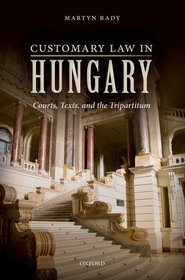
Customary Law in Hungary
Courts, Texts, and the Tripartitum
-
10% KEDVEZMÉNY?
- A kedvezmény csak az 'Értesítés a kedvenc témákról' hírlevelünk címzettjeinek rendeléseire érvényes.
- Kiadói listaár GBP 117.50
-
56 135 Ft (53 462 Ft + 5% áfa)
Az ár azért becsült, mert a rendelés pillanatában nem lehet pontosan tudni, hogy a beérkezéskor milyen lesz a forint árfolyama az adott termék eredeti devizájához képest. Ha a forint romlana, kissé többet, ha javulna, kissé kevesebbet kell majd fizetnie.
- Kedvezmény(ek) 10% (cc. 5 614 Ft off)
- Kedvezményes ár 50 522 Ft (48 116 Ft + 5% áfa)
Iratkozzon fel most és részesüljön kedvezőbb árainkból!
Feliratkozom
56 135 Ft

Beszerezhetőség
Megrendelésre a kiadó utánnyomja a könyvet. Rendelhető, de a szokásosnál kicsit lassabban érkezik meg.
Why don't you give exact delivery time?
A beszerzés időigényét az eddigi tapasztalatokra alapozva adjuk meg. Azért becsült, mert a terméket külföldről hozzuk be, így a kiadó kiszolgálásának pillanatnyi gyorsaságától is függ. A megadottnál gyorsabb és lassabb szállítás is elképzelhető, de mindent megteszünk, hogy Ön a lehető leghamarabb jusson hozzá a termékhez.
A termék adatai:
- Kiadó OUP Oxford
- Megjelenés dátuma 2015. augusztus 6.
- ISBN 9780198743910
- Kötéstípus Keménykötés
- Terjedelem280 oldal
- Méret 240x175x24 mm
- Súly 578 g
- Nyelv angol 0
Kategóriák
Rövid leírás:
The first comprehensive treatment in any language on the history of customary law in Hungary, starting with Stephen Werboczy's customary law code, the Tripartitum. This code influenced the composition, structure, and procedures of the courts and retained authority even when a parliamentary government was established in the nineteenth century.
TöbbHosszú leírás:
This is the first comprehensive treatment in any language of the history of customary law in Hungary, from the thirteenth to the twentieth centuries. Hungary's customary law was described by Stephen Werboczy in 1517 in the extensive law code known as the Tripartitum. As Werboczy explained, Hungarian law derived from the interplay of Romano-canonical law, statute, written instruments, and court judgments. It was also responsive, however, to popular conceptions of the law's content and application, as communicated through the lay membership of the kingdom's courts. Publication of the Tripartitum was intended to make the law more certain by fixing it in writing. Nevertheless, its text was customized by actual use, in the same way as the statute laws of the kingdom were adjusted as a consequence of court practice and of errors in their transmission.
The reputation attaching to the Tripartitum and Hungary's insulation from the Roman Law Reception meant that the Tripartitum continued to retain authority until well into the nineteenth century. Attempts to replace it foundered and it was the principal text on which the courts and the schools relied, not only in Habsburg Hungary but also in Transylvania. Courts, nevertheless, continued to modify its provisions in the interests of rendering judgments that they deemed either to be right or in conformity with developing practices. Even after the establishment of a parliamentary form of government in the nineteenth century, a strong customary element attached to Hungarian law, which was amplified by the association of customary law with national traditions. The consequence was that Hungary maintained aspects of a customary law regime until the Communist period.
Martyn Rady's monograph is a remarkable overview about a large part of Hungarian legal history. Not only does it provide an insight into the history of sources and judicial organization, but it also demonstrates the essence and development of many important legal institutions in the field of private law, criminal law, procedural law and constitutional law.
Tartalomjegyzék:
The Legal Landscape
Customary Law and the Tripartitum
Customary Law, Legislation, and Letters
Customary Law and Medieval Courts
King and Nobility
The Nobleman and His Land
Crime and Prosecution
Medieval Procedure and Judicial Decision Making
Early Modern Legal Institutions
Codification after the Tripartitum
Courts and the Law in the Long Eighteenth Century
Custom and Law in the Modern Period
Conclusion: Customary Law in Hungary




